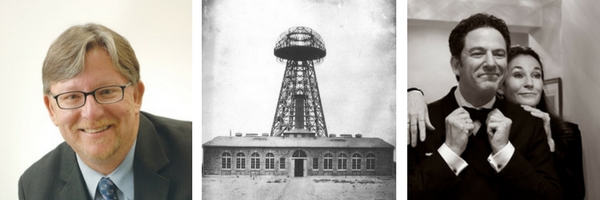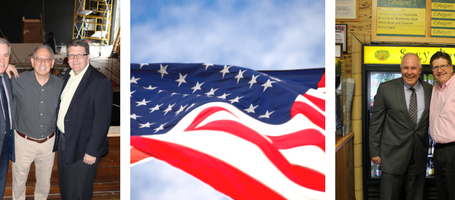
John Kominicki – It is with sadness that I write this unexpected tribute to my friend. To me, John was a role model and mentor, and served as an inspiration for me even starting to pen “Off the Record.” Many times, he and I would lament together about how so many people are talking, but no one is really saying anything. John was a warrior, a necessary mouthpiece for Long Island businesses during many critical times, and his voice will certainly be missed. I offer my heartfelt condolences and prayers for his family, and hope our friend rests in eternal peace.
White Privilege – I can remember the first time I was introduced to the concept of “white privilege” – my blood boiled in rage. How dare someone even insinuate that I have gotten where I am today because of some “privilege.” Don’t they know that I have been working non-stop since I started picking peaches at Davis Peach Farm at 12 years old, that I went into the Marine Corps out of high school not only to serve my country but also to be able to afford to go to college under the GI bill, that I worked full-time during the day while a college student and went to school at night, that I worked my entire time in law school, and so on? That doesn’t sound like privilege to me; that sounds like hard work.
Today, I still wince a little when I hear folks use the term “white privilege,” and I do believe that the best way for a person, any person, to move their life forward is to get up every morning and work as hard as they possibly can. But I also have evolved (somewhat), and I’ve managed to become much more empathetic to the bigger point I believe folks are trying to make. The way I process it, the point is not about diminishing any of the accomplishments I have been able to achieve as a white male, but instead it’s an acknowledgment that those accomplishments are difficult enough, and become even more difficult when there are additional factors one group of citizens must deal with that another group does not have to, particularly over several generations.
For black Americans, it was only 152 years ago that our laws were changed to recognize that they even have rights as human beings, rather than property that could be owned by white folks. Following the Civil War and emancipation, no support was given to the newly freed slaves by the federal or state governments, and as a result rampant discrimination continued via Jim Crow laws and segregation, which resulted in low-paying jobs and no housing. It wasn’t until 1964 (53 years ago and almost 100 years after emancipation) that laws were finally enacted so that racial discrimination could be legally challenged, and as we know discrimination is still being challenged today. All of this has resulted in the modern-day inner cities that remain occupied predominantly by black Americans, where there is a disproportionately high amount of unemployment, poverty, broken families, crime and drug use. This is a direct result of our country’s very dark history, leaving the black community with little economic or political power to help develop and revitalize these communities, while other white communities thrived (there is no doubt in my mind that had the African community voluntarily migrated here, rather than being brought over involuntarily as slaves, they would be in a significantly better position today). For our nation to thrive, we need to create a better balance of economic and political power across the different races, particularly white and black.
Once again, it’s going to take private business, and not government, to take the leadership role in solving the crises our inner cities are facing. There needs to be significant private investment in these communities to revitalize not just the infrastructure, but also to help create jobs and train and put to work an existing but underutilized labor force. Doing so will not only increase the real estate value for those neighborhoods (and the investors), but will also put folks to work, which will help grow our production and GDP, and will lessen the tax burden by reducing the government spend on things like unemployment, welfare, prisons, police presence, etc. This to me exemplifies the true American entrepreneurial spirit.
But this investment is going to need to come in large part from black communities and their leaders partnering with “white” dollars, and it is going to take government help in the form of real incentives to help convince investors to put enough dollars into these communities to truly make a difference. For this to happen, we need the leadership on both sides (black/white, not Democrat/Republican) to work together and lead us forward – that means no more finger-pointing but instead changing the dialogue from white vs. black to that of green, and American prosperity. I’m not suggesting this is easy; the scars are understandably deep, but I do believe that us working together as private American citizens, and not relying on the dysfunctional world of government, is our best chance to solve these difficult problems.
AROUND TOWN
Ribbon-Cutting Celebration – Last Thursday we were honored to attend a ribbon-cutting ceremony and party celebrating the move of Lorraine Gregory Communications into their spacious new home in the Heartland Business Park. If you love Long Island success stories as much as I do, please join me in congratulating my friend Greg Demetriou, Founder and CEO, on a spectacular job building a full-service marketing and communication agency right in our backyards.
Staller Center for the Arts – I kicked off the holiday season last Saturday night at the Staller Center for the Arts at Stony Brook University, where husband-and-wife vocal team John Pizzarelli and Jessica Molaskey performed seasonal favorites and jazz standards, accompanied by the Swing 7 Band. I’m on the Advisory Council for the Staller Center, so it makes me especially proud that while I always enjoy a night out in the city, I don’t need to leave my zip code to celebrate the arts. Check out their full calendar here.
Admin Holiday Dinner – In addition to celebrating the season with a firm-wide holiday party, at CMM we also take part in more intimate gatherings with our respective teams – a litigation dinner, corporate party, and so on. My operations team got together on Tuesday night for a fantastic dinner at Insignia, where we toasted to even greater success in 2018 and made fun of the attorneys (kidding, not). These are the people that keep the office running, and I always enjoy the opportunity to spend time and express my thanks to this group for all their hard work. They are all incredibly talented and I am very proud of them.
Looking Ahead – My partners and I have been working with Cape Horn StrategiesFounder and CEO Brian Turchin to set goals for our three-year, five-year, and ten-year plans. Brian really “gets it” when it comes to growing the value of your business and planning for that growth. We had a great meeting on Wednesday, and look forward to continuing to work with him.
Tesla – I recently became the National Chair of the Advisory Board for the Tesla Science Center at Wardenclyffe, home to the only remaining lab where Nikola Tesla (the inventor of alternating current electricity and neon lighting) conducted research. The Shoreham facility is being developed into a science-focused Center, housing both a museum about Long Island’s rich scientific opportunities past, present, and future, and a business incubator for fledgling companies engaged in scientific research. On Thursday, I met with Executive Director (and my CMM colleague) Marc Alessi as well as Marc Saffren, from M3 Development, to discuss major plans for the Tesla Center in the new year. If you’re interested in an Advisory Board seat, please let me know. Stay tuned for details…



